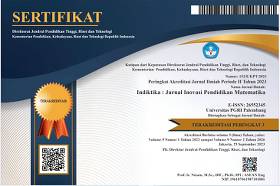Pembelajaran Sudut melalui Tarian Kreasi Sumatera Selatan Menggunakan Pendekatan Pendidikan Matematika Realistik Indonesia di SMP
DOI:
https://doi.org/10.31851/indiktika.v6i1.13210Abstract
Tujuan dari penelitian ini adalah memperoleh gambaran pembelajaran sudut menggunakan pendekatan Pendidikan Matematika Realistik Indonesia (PMRI) di Sekolah Menengah Pertama yang ditinjau dari dua aspek yaitu: aktivitas siswa selama pembelajaran, respon atau sikap siswa pada pembelajaran. Subjek penelitian adalah siswa kelas VII SMP N 18 Palembang yang terdiri dari 32 siswa. Metode penelitian yang digunakan penelitian deskriptif kualitatif dan kuantitatif. Teknik pengumpulan data adalah observasi untuk mengetahui aktivitas siswa selama proses pembelajaran berlangsung, serta dokumen untuk mengetahui hasil kerja Lembar Kerja Peserta Didik (LKPD) saat proses pembelajaran untuk mengetahui kemampuan siswa. Dari analisis data disimpulkan bahwa hasil observasi menunjukkan semua siswa aktif mengikuti pembelaran dengan baik. Dari analisis data dapat disimpulkan bahwa hasil observasi menunjukkan semua siswa aktif mengikuti pembelajaran dengan baik. Dari hasil kerja siswa pada LKPD dan latihan menunjukkan bahwa semua siswa mampu menyelesaikan pembelajaran materi sudut dengan rata-rata 84,75 termasuk kategori sangat baik. Sedangkan hasil observasi keterlaksanaan guru dalam proses pembelajaran mulai pendahuluan, kegiatan inti, dan penutup sudah terlaksana dengan baik.
References
Biber, C., Tuna, A., & Korkmaz, S. (2013). The Mistakes and The Misconceptions of The Eighth Grade Students on The Subject of Angles. European Journal of Science and Mathematics Education, 1(2), 50-59.
Bustang, B., Zulkardi, Z., Darmawijoyo, D., Dolk, M., & Van Eerde, H. (2013). Developing A Local Instruction Theory for Learning The Concept of Angle Through Visual Field Activities and Spatial Representations. International Education Studies, 6(8), 58-70.
Destrianti, S. (2019). Etnomatematika dalam Seni Tari Kejei Sebagai Kebudayaan Rejang Lebong. Jurnal Equation: Teori dan Penelitian Pendidikan Matematika, 2(2), 116-132.
Devichi, C., & Munier, V. (2013). About The Concept of Angle in Elementary School: Misconceptions and Teaching Sequences. The Journal of Mathematical Behavior, 32(1), 1-19. doi:https://doi.org/10.1016/j.jmathb.2012.10.001
Fauzan, A., Yerizon, Y., & Yulianti, D. (2020). The RME-Based Local Instructional Theory for Teaching LCM and GCF in Primary School. Journal of Physics: Conference Series, 1554(1), 012078.
Fyhn, A. B. (2008). A Climbing Class' Reinvention of Angles. Educational Studies in Mathematics, 67(1), 19-35.
Galen, F. v., & Eerde, D. v. (2018). Mathematical Investigations for Primary Schools. Utrecht: Utrecht University.
Hariastuti, R. M., Budiarto, M. T., & Manuharawati, M. (2021). Indonesian Traditional Dance: Ethnomathematics on culture as a basis of learning mathematics in elementary schools. Elem. Educ. Online, 20(1), 936-947.
Lester, F. K. (2007). Second Handbook of Research on Mathematics Teaching and Learning: A project of the National Council of Teachers of Mathematics. IAP.
Lusiana, Hartono, Y., & Saleh, T. (2013). Penerapan Model Pembelajaran Generatif (MPG) untuk Pelajaran Matematika di Kelas X SMA Negeri 8 Palembang. Jurnal Pendidikan Matematika. 3(2), 29-47.
Mahanal, S. (2014, September). Peran Guru Dalam Melahirkan Generasi Emas Dengan Keterampilan Abad 21. Seminar Nasional Pendidikan HMPS Pendidikan Biologi FKIP Universitas Halu Oleo, 1, 1-16. Kendari: Universitas Halu Oleo.
Mannone, M., & Turchet, L. (2019). Shall We (Math and) Dance?. Mathematics and Computation in Music: 7th International Conference, MCM 2019 (pp. 84-97). Madrid, Spain: Springer International Publishing.
Maritaria, T., & Mariana, N. (2019). Eksporasi Konsep Matematika Sekolah Dasar dalam Tari Kreasi. JPGSD, 7(3), 3029-3039.
Nada, L. Q. (2020). Studi Kepustakaan: Contextual Teaching and Learning (CTL) untuk Meningkatkan Pemahaman Konsep Matematika Siswa di Era Merdeka Belajar. Prosiding Konferensi Ilmiah Pendidikan Universitas Pekalongan, 1, 136-140. Pekalongan: Universitas Pekalongan.
Ngaeni, E. N., & Saefudin, A. A. (2017). Menciptakan Pembelajaran Matematika yang Efektif dalam Pemecahan Masalah Matematika dengan Model Pembelajaran Problem Posing. Jurnal Aksioma, 6(2), 264-274.
Nuraida, I., & Amam, A. (2019, September). Hypothetical Learning Trajectory in Realistic Mathematics Education to Improve the Mathematical Communication of Junior High School Students. Infinity Journal, 8(2), 247-258.
Rahmah, N. (2013). Hakikat Pendidikan Matematika. Al-Khwarizmi: Jurnal Pendidikan Matematika dan Ilmu Pengetahuan Alam, 1(2), 1-10.
Rawani, D. (2023). The Reflective Teaching Practicws using PMRI and Collaborative Learning. Jurnal Pendidikan Matematika, 17(1), 69-88.
Rawani, D., Putri, R. I., & Hapizah. (2019, May). Pisa-Like Mathematics Problems: Using Taekwondo Context of Asian Games. Journal on Mathematics Education, 10(2), 277-288.
Rawani, D., Putri, R. I., Zulkardi, & Susanti, E. (2023). RME-Based Local Insstructional Theory for Translation and Reflection Using of South Sumatra Dance Context. Journal on Mathematics Education, 4(3), 545-562.
Rhodes, A. M. (2006). Dance in Interdisicplinary Teaching and Learning. Journal of Dance Education, 6, 48-56.
Ribeiro, S. C., Palhares, P. M., & Portugal, M. J. (2020). Ethnomathematical Study on Folk Dances: focusing on the choreography. Revemop, 2.
Sciarappa, L., & Henle, J. (2022). Square Dance from a Mathematical Perspective. The Mathematical Intelligencer, 44(1), 58-64.
Solehah, I. P. (2021). Analisis Miskonsepsi Siswa pada Materi Garis dan Sudut Ditinjau dari Gaya Belajar Siswa Kelas VII SMP Negeri 13 Surakarta Tahun Ajaran 2018/2019. Universitas Sebelas Maret.
Downloads
Published
Issue
Section
License
Copyright (c) 2023 Dewi Rawani, Dina Octaria

This work is licensed under a Creative Commons Attribution-ShareAlike 4.0 International License.
This work is licensed under a Creative Commons Attribution-ShareAlike 4.0 International License.
Authors who publish with this journal agree to the following terms:
- Authors retain copyright and grant the journal right of first publication with the work simultaneously licensed under a Creative Commons Attribution License that allows others to share the work with an acknowledgement of the work's authorship and initial publication in this journal.
- Authors are able to enter into separate, additional contractual arrangements for the non-exclusive distribution of the journal's published version of the work (e.g., post it to an institutional repository or publish it in a book), with an acknowledgement of its initial publication in this journal.
- Authors are permitted and encouraged to post their work online (e.g., in institutional repositories or on their website) prior to and during the submission process, as it can lead to productive exchanges, as well as earlier and greater citation of published work.












